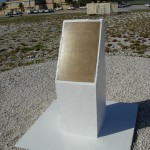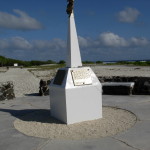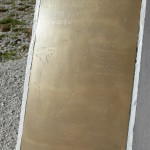Guamanians on Wake
 The Guamanian memorial stands proudly in Memorial Row on Wake Island. The delicately engraved plaque has been obscured by a well-intentioned but misguided attempt to mitigate weathering by applying a protective coating. One has to squint and shift a bit until the light hits it just right to make out the names. Context is not offered: the casual observer might wonder who they were and how they fit in to the saga of World War II on Wake Island.
The Guamanian memorial stands proudly in Memorial Row on Wake Island. The delicately engraved plaque has been obscured by a well-intentioned but misguided attempt to mitigate weathering by applying a protective coating. One has to squint and shift a bit until the light hits it just right to make out the names. Context is not offered: the casual observer might wonder who they were and how they fit in to the saga of World War II on Wake Island.
The Guamanians, or Chamorros, were employees of Pan American Airways. In 1935 the airline obtained permission from the U. S. government to build stations on Wake Island, Midway, and Guam for its transpacific clipper operation. Once the rudimentary stations were built and lagoons blasted to clear seaplane runways, Pan Am shipped in pre-fab hotels with all the modern amenities for its high-end transpacific clientele. The airline found a ready, willing, and able (and cheap) labor source for the stations and hotels in the Chamorro population of Guam. In many contemporary and postwar accounts the Chamorros were categorized as white-jacketed “boys,” but in reality they were men, working at the Pan American stations in a variety of occupations as carpenters, mechanics, boatmen, construction workers, clerks, cooks, artisans, and, yes: waiters, porters, and mess men. My grandfather often mentioned the “Pan Air” fellows fondly in his letters from Wake in 1941.
On December 8, 1941, the Japanese attacked Wake Island in a stunning raid that targeted the airstrip on Wake and the Pan American facilities on Peale.
On Peale the Pan American conflagration burned hopelessly out of control. Stunned civilian workers emerged from their hiding places, rushing to help where they could or making their way across the bridge to camp. Most of the Clipper passengers, crew, and employees had thrown themselves flat on the ground outdoors or into ditches and drainpipes, as did Captain Hamilton, who had just returned from the airfield with a reconnaissance flight plan for the Clipper. Bleeding and stunned, manager John Cooke turned to the hotel, “badly battered and one wing was already ablaze. . . . Every Pan Am Building had been hit and several were burning. Power was gone and radio was gone, all was gone. The station had been rendered useless.” The attack killed ten Pan American Chamorro employees, cut to shreds or burned to death in the fires that destroyed the Pan Air complex. Scorched survivors struggled to pull the charred bodies of their friends and kin out of the inferno and gingerly placed the injured in vehicles for transport to the hospital. (Building for War, 204)
The remains of the ten dead Chamorros were placed inside the camp’s refrigerated reefers along with nearly thirty American dead from that first day’s attack. Survivors scrambled to put out the fires and regroup for what lay ahead as the bullet-scarred Pan American Philippine Clipper prepared for a quick escape. Employees gutted the plane of mail sacks, cargo, and luggage and tore out seats to make way for a maximum passenger load. The crew, passengers, and all of the American (white) PAA employees were hustled onto the clipper. When two Chamorro stowaways were found they were booted off – an “unfortunate time to draw the color line,” as navy commander W. S. Cunningham later observed in his memoir. The overloaded clipper lifted off on the third try and disappeared into the eastern sky.
All of the Guamanian Pan American employees were left on Wake: ten were dead and thirty-five faced whatever the future held. One American PAA employee, Waldo Raugust, missed the flight and also remained on Wake. Like the American civilian contractors, the Pan American employees did what they could to aid the defense as they waited for the rescue that never came. When the Japanese took Wake two weeks later, all disappeared behind the curtain of war. Two more Guamanians would die in Japanese POW camps before the end of the war. Thirty-three survived and returned home to Guam or the U. S., but their story was swallowed by time.
On December 7-8, 1991, a small contingent of aging Guamanian survivors visited Wake Island with Senator Gordon Mailloux to dedicate their memorial. Even in Guam little was known of these forty-five Pan American employees caught by war on Wake in 1941 until they were recognized as U.S. veterans, along with the American civilian contractors of Wake Island in 1981. The Chamorro survivors were proud of their role in the defense of Wake, and they made a commitment to honor their fallen brothers with this memorial.*
The memorial plaque reads: “Wake Island Defenders from Guam/ Never did so few do so much for so little/ Dec 1941” An outline of the island of Guam is etched into the plaque, and to the right are depicted the flags of the United States and Guam. Below these are listed the names of the ten Guamanian men killed in action, two killed in captivity, and the virtually unreadable list of the survivors. At the bottom, “This plaque donated by Guam Historical Museum.” It takes some effort to make out the names now, but it is well worth the time to honor these brave men.
*Although the ten Chamorro dead are interred in the mass grave of Wake’s war dead in Punchbowl cemetery in Hawaii, their names are not engraved on the marker.
- Memorial row on Wake Island, south to north: USMC (foreground), Guamanian (white block, left center), US Civilian (dark granite with low rock wall), Japanese (white block in distance)
- Original Guam Memorial



